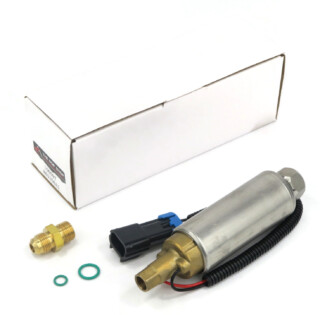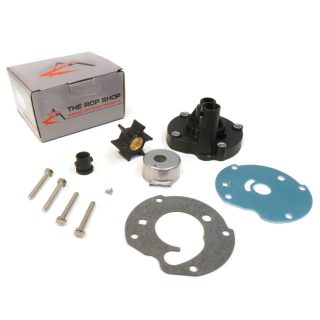
Winterizing Your Boat: Key Steps [Printable Checklist]
Falling temperatures mean that it’s time to savor the fun and freedom of your final boat outings as you turn your attention over to winterizing your boat.
You may be sad to be putting things away for the season. The good news is that the boat winterizing process will give you a chance to say “so long for now” to your beloved watercraft while also helping to keep it in good shape. This way, you can keep enjoying it for years to come.
Follow along to learn how to winterize your boat. (Plus, even if you’re able to use your boat year-round, there are several systems and pieces of equipment aboard that require special maintenance. Why not handle that now?)
Don’t forget that it's a good idea to check your boat's owner's manual first for any specific procedures that need to be followed.
Stay tuned to the end for a printable boat winterization checklist you may find helpful as you're prepping your watercraft.
ENGINE CARE
As strange as it might seem, water is the enemy—at least when it comes to winterizing your boat.
Unlike most liquids, water expands as it freezes, so if it’s left in your boat’s systems through the winter, it can cause a lot of damage. That’s why it’s important to remove all the water that you can from your boat. (You’ll notice “water removal” as a theme throughout this article for that very reason.)
Engine care can be a little tricky since the exact procedures vary on your boat's engine type. Here are some guidelines for all engine types followed by additional advice specific to one or the other1:
All engines
- The oil and the oil filter need to be changed to get rid of residue that can be harmful to your boat.
- Run the engine for several minutes prior to changing the oil for better results.
- Thoroughly drain water from the engine.
- Fog your engine to help protect against corrosion and rust.
Inboard engines
- If your engine is cooled by raw water (i.e. seawater is pumped into the system to cool it), you’ll want to flush the system with a propylene glycol antifreeze.
- Even if you have a freshwater-cooled engine, you’ll still need to do this for the raw-water side.
- Be sure to let the engine heat up to normal operating temperature and keep the thermostat open prior to putting in the antifreeze.
Outboard engines
- Change out your lower unit gear lubricant—this might be easier if you run the engine to warm it first.
- Flush the engine—depending on how new your engine is, it might have a garden hose fitting to make this process easier.
- Store the engine tilted downwards so water can drain properly.





PLUMBING SYSTEM
Does your boat have extra water fixtures, like a sink or a shower?
You guessed it—you’ll have to drain those and run antifreeze through them as well.
Get as much water out of the system as possible by turning on a water fixture (or several) and letting it run until the tank and lines are empty. After that, you’ll take the primary feed hose and put it in a bucket of propylene glycol antifreeze. Run every fixture, hot and cold, until you see antifreeze coming out. After that, you can replace the feed hose.2
This is also the time to clean out your MSD toilet, if your boat has one. Run fresh water through the system and empty the holding tank. Flush with fresh water again, and then run the same antifreeze through the system.2
(Skip this crucial step when you're winterizing your boat, and you’ll be in for an unpleasant surprise later on, to say the least.)
FUEL SYSTEM
This first part is pretty easy: change your fuel filter and check it while the engine is running to make sure it isn't leaking.1
Here's where it gets a bit controversial. There’s some debate on whether you should drain your fuel at the end of the season or do the complete opposite (fill it and add stabilizer). However, Discover Boating states that you should fill your tank and use a fuel stabilizer based on recommendations from manufacturers and technicians of marine engines.
Filling your tank limits the amount of condensation that can form in your boat’s fuel tank, and stabilizer prevents the gasoline from going bad, which can happen in as soon as 60 days. Be sure to run your boat once the stabilizer is in there so that it has a chance to distribute around the fuel system.4

OTHER
- Remove your battery from your boat. Consider using a trickle charger to keep it from losing too much charge.2
- Give your boat a good cleaning. It’s probably the last thing you want to do after all the work you’ve done to get here, but you don’t want dirt or gunk to be sitting there all winter, do you? Plus, leaving that dirt to sit can permanently damage your boat's finish.2
- Cover and store your boat. You could also shrink-wrap it if you'd like.4
Tips for In-Water Storage
Planning to keep your boat in the water all winter? It can be done, but you'll need to take some extra measures to do it successfully. Here are a few steps for in-water storage from Discover Boating:
- Check for leaks in rudder shaft and stuffing boxes.
- Close all seacocks.
- Ensure bilge pumps function correctly, can be activated with the float switches, and are not blocked by debris.
- Do periodic check-ins on your boat to make sure there are no leaks or surprise animal tenants.
- If needed, use water agitators below your boat to pull warm water up and help it avoid being iced in.





Boat Winterizing: Conclusion
It might be a pain, but taking care of your boat is an investment that will have massive payoff in the future. Proper boat winterization helps to make sure you can keep enjoying your watercraft with fewer worries.
If you find that you need any parts during this process, be sure to check out our selection of quality boat parts.
Don't forget to read our blog on spring boating preparation when winter is over!
What other winter preparations do you need to make?
There's a good chance that you have other power equipment that needs to be made ready for the upcoming season. Why not take care of it while you're in the winterizing zone?
Whether it's a purely-for-fun machine like a snowmobile, your trusty lawn equipment, or your ATV (which could count as both), let us help you out with our Rugged U resources. We're here to help you get back to the outdoors.
Printable boat winterization checklist
If you need a printable summary of what we discussed, we have you covered.
(Not showing up correctly? You can also find it here: boat winterization checklist.)
[REVISED 8/2023]
- https://www.boatus.com/expert-advice/expert-advice-archive/2013/july/how-to-winterize-boat-engines-and-drives
- https://www.boats.com/how-to/how-to-winterize-a-boat/
- https://www.discoverboating.com/resources/winterizing-your-boats-fuel-tank
- https://www.goldeagle.com/tips-tools/how-winterize-your-boat/
- https://www.discoverboating.com/ownership/storage/winterizing

Having trouble using your ROP Shop pressure washer surface cleaner? These tips can help you out.

Thinking about getting a pressure washer? Here are eight advantages to owning a pressure washer to help convince you.

Installing a new pressure washer pump doesn’t have to be a hassle. Let The ROP Shop walk you through it.

Ready to learn how to pressure wash quickly, effectively, and safely? Check out these eleven tips.